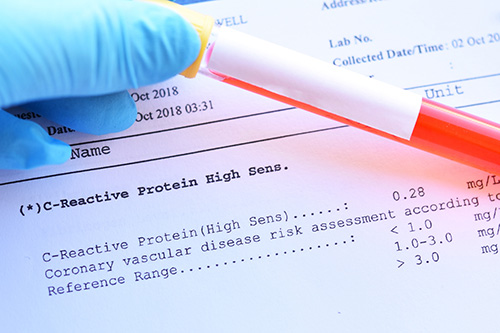Inflammation is finally being recognized in conventional medical circles as a prime contributor to serious health concerns in women, e.g., heart disease, osteoporosis, diabetes, cancer, and Alzheimer’s disease — to name just a few. A simple test called C-reactive protein (CRP) can help determine whether inflammation is present in your body — including the vessels around your heart.

CRP is mainly released by the liver into the bloodstream in the presence of inflammation, including when there is an infection.. Generally speaking, inflammation is a sign that your body’s immune system is reacting to injured or infected tissue. Although your immune system is only doing its job, too much inflammation, or an ongoing inflammatory response, can lead to problems.
When most of us think of inflammation, we imagine pain, swelling and redness. But we now know that chronic, low level inflammation can be present without these symptoms, while it’s still, insidiously, contributing to disease. This low-grade inflammation is particularly influenced by our nutrition, stress level, and environmental toxicity. Over time it can cause problems, such as heart disease, the conditions mentioned above.
Although there is no definitive agreement on when to order CRP testing or who should have it, most practitioners in conventional medicine use this test to monitor acute infection or distinctly inflammatory disorders like arthritis or inflammatory bowel disease. However, doctors are becoming increasingly aware of CRP’s value in assessing cardiovascular risk.
CRP and cardiovascular risk
The AHA/CDC (American Heart Association/Centers for Disease Control) have jointly established levels of cardiovascular risk according to the following CRP values:
Low risk: less than 1.0 mg/L
Average risk: 1.0-3.0 mg/L
High risk: above 3.0 mg/L
More subtle changes in CRP are measured with a test known as hs-CRP, or high-sensitivity-CRP. However, when treating patients, many practitioners don’t order an hs-CRP because they don’t know what to do if it’s elevated.
In 2003, the American Heart Association with the Centers for Disease Control and Prevention jointly published their recommendations for the clinical use of these tests, explaining that CRP values are only useful as an independent marker of risk for cardiovascular disease, and that CRP testing should not be used as a widespread screening tool or to track treatment.
That may change with the recent publication of a large worldwide study that found people with high levels of hs-CRP who use a common statin drug benefit from a reduction in risk of heart attack or stroke. (Note that statin drugs are generally prescribed to lower cholesterol but also reduce inflammation.) Testing for hs-CRP may become the norm, and that’s going to be a good thing!
CRP is an extremely important preventive marker. When elevated, there are many steps you can take to dampen the inflammatory cascade and limit your risk of inflammation-related disorders, without signing up for lifelong prescription drugs and their problematic side effects. By improving digestion and nutrition (e.g., including colorful fruits and vegetables, but reducing sweets), low-grade inflammation (along with CRP levels) can be reduced significantly. You might also consider adding anti-inflammatory spices such as ginger and turmeric to your meals, .










